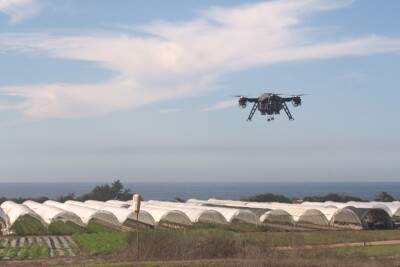Recently, Commercial UAV News spoke with Sasha Mela, Lead Aerospace Engineer and Co-Founder of Venture Aerospace. A Colorado-based company, Venture Aerospace focuses on the development of engines, materials, and aircraft, including heavy-lift drones.
In our conversation, Mela discusses her firm’s current work on a fuel-agnostic generator, how the company’s products can impact the drone-based operations, and Venture Aerospace’s unique approach to product design and development.

Commercial UAV News: What are you currently working on at Venture Aerospace?
Mela: We always have multiple projects going at once, but we are primarily working on making a fuel agnostic generator, which is the powerhouse for the drones. We have already developed a fuel agnostic combustion chamber that we’ve tested with kerosene, diesel, canola oil, and gasoline. We’re in the process of scaling this combustion chamber down to 1/3 of its size. Multiple combustion chambers will be attached to two impellers, fed by an internally integrated pump. We are also working on an incredibly strong material to serve as the casing for the generator which is also the material for our drone.
The importance of the generator’s ability to be able to use biodiesel or biogas cannot be understated. It can be used in communities with a lack of fuel resources, but rich in organic waste material. They will be able to create their own fuel by utilizing their organic waste or by sowing plants with the intent to create biogas—both resulting in a carbon negative process.
Commercial UAV News: What kinds of applications would be best suited for the engine?
Mela: The aim is to use this engine not only as a lightweight generator that can be carried onto boats, remote homesteads, and emergency disaster locations affected by power loss—but also as a plug-and-play device in our line of drones—Fury and Baby Dragon—as well as drones available on the market today. Unfortunately, we will not be able to use alcohol or biogas as the primary fuel when the engine is placed in a drone due to power density considerations but it’s ability to use any fuel (or fuel mixture) is still appreciated.
Commercial UAV News: What kinds of commercial enterprises that use drones in their operations would be helped by Venture Aerospace technologies?
Mela: Many of our products and technologies can help drone-based applications. For example, we offer cost-effective, easy-to-manufacture body material and 3D-metal-printed engines. Creating a universal material that can be manufactured in virtually any setting with robotic labor makes the material valuable to virtually everyone in the drone industry around the world. In fact, it could encourage new markets to emerge. Cost-effectiveness is useful in the private sector where an abundance of drones is needed for applications such as surveying and delivering packages and in the military sector where no expense justifies the loss of life—these drones can be sent out in large numbers without the threat of destruction or care of capital lost.
Next, the battery-powered tethered version of our large drone, the Fury, can be easily used in construction settings in lieu of cranes. It can lift approximately 350 lbs. for a useful amount of time before the batteries need to be charged again. The low price point will make it accessible to every building company, small or large.
Also, the higher thrust-to-weight ratio of our engine will be extremely beneficial to current surveying drones carrying a small lidar payload. Our engine will allow them to fly for longer periods of time, with a greater payload. For example, 5 lb. of an image stabilization platform could be added to a 10 lb. lidar system for enhanced performance.
Commercial UAV News: Discuss the development process at Venture Aerospace. How does a project go from concept to reality?
Mela: A lot of my daily work goes into the research and application of our hypothesis to create a system or product worthy of cost-effective mass production on a global scale. We want our technology to be accessible to organizations/individuals around the globe with lacking fuel availability or budgetary restrictions.
So, working at Venture Aerospace is like working in an exciting Mad Scientist’s lab. We design for production and go back to basics constantly. We will always be standing on the shoulders of giants. I can refer to every paper and patent that has been utilized to help us move forward and attain our own patent publications. When we have an idea, we will develop our engineering and scientific methods to create a plan of attack. We have brought a great deal of our prototype production in house with a CNC machine, multiple 3-D printers, and woodshop. We spend a great deal of time creating and testing variations of our prototypes before we enlist local manufacturers to help us create the final product. When I started at Venture Aerospace and Dr. Vaughan Clift told me to create a combustion chamber, I thought it was to get to know my design sense. After a few months of design changes, discussions, and a lot of research, we had the engine printed which worked the first time we lit it.
Another strength we have is the ability to recognize when we are not the experts on a specific topic. We venture out to conferences, local manufacturers and even companies that could be seen as competitors to get their insight and learn from them. It’s amazing how many people are willing to generously share their wealth of information with us. This has helped us learn how to create some products in a much shorter time frame and helped us with innovative discoveries as our findings often contradicted popular wisdom—an extremely important part of the patent review process.
Commercial UAV News: What’s next for Venture Aerospace?
Mela: The main thing right now is finalizing the impeller design and getting it to production. This iterative process is highly involved and attention to detail is paramount. We want to ensure we tackle this stage diligently to ensure that when we involve an OEM that we will not have to make any changes. The next step will be creating a fully integrated generator including all our technology. Once our product is on its way to market, we will adapt the generator to be used as the powerhouse for the Fury and Baby Dragon. We will work with our partners in the drone industry to integrate flight controls. In the future we will incorporate concepts like machine learning for plant identification and analytical software to aid the farming industry.
















Comments